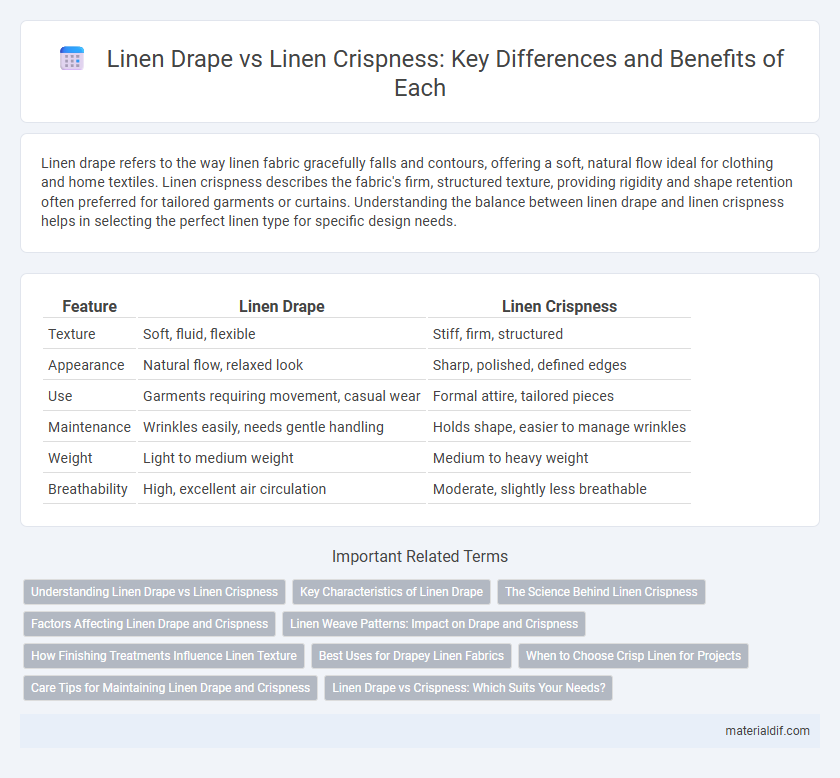Linen drape refers to the way linen fabric gracefully falls and contours, offering a soft, natural flow ideal for clothing and home textiles. Linen crispness describes the fabric's firm, structured texture, providing rigidity and shape retention often preferred for tailored garments or curtains. Understanding the balance between linen drape and linen crispness helps in selecting the perfect linen type for specific design needs.
Table of Comparison
| Feature | Linen Drape | Linen Crispness |
|---|---|---|
| Texture | Soft, fluid, flexible | Stiff, firm, structured |
| Appearance | Natural flow, relaxed look | Sharp, polished, defined edges |
| Use | Garments requiring movement, casual wear | Formal attire, tailored pieces |
| Maintenance | Wrinkles easily, needs gentle handling | Holds shape, easier to manage wrinkles |
| Weight | Light to medium weight | Medium to heavy weight |
| Breathability | High, excellent air circulation | Moderate, slightly less breathable |
Understanding Linen Drape vs Linen Crispness
Linen drape refers to the fabric's natural ability to flow and conform softly around shapes, creating a relaxed and fluid silhouette. Linen crispness describes the material's stiffness and structured texture, lending garments a sharp, tailored appearance. Understanding the balance between linen drape and crispness helps designers optimize comfort and style for various applications, from casual wear to formal attire.
Key Characteristics of Linen Drape
Linen drape is characterized by its fluidity and natural softness, allowing fabric to hang gracefully and enhance garment silhouette. Unlike linen crispness, which emphasizes stiffness and structure, linen drape offers flexibility and a relaxed fit ideal for breathable, comfortable clothing. High-quality linen with excellent drape typically features fine yarns and a smooth weave, contributing to its elegant flow and lightweight feel.
The Science Behind Linen Crispness
Linen crispness arises from the unique structure of flax fibers, which contain cellulose molecules tightly packed into crystalline regions, providing rigidity and firmness. The drape of linen fabric depends on fiber fineness and weave density, influencing how the material falls and conforms to shapes. Understanding the microscopic fiber arrangement and moisture absorption properties is essential to balance linen's natural stiffness with its characteristic smooth drape.
Factors Affecting Linen Drape and Crispness
Linen drape and crispness are influenced by fiber length, yarn twist, and fabric weave; longer fibers and tighter yarn twists typically enhance linen's stiffness and crispness. Fabric weight and finishing processes such as calendaring or enzyme treatments also impact the drape, with lighter weights and softer finishes promoting better flow and flexibility. Moisture content and environmental conditions affect linen's behavior, as the fiber absorbs humidity, altering both drape and firmness.
Linen Weave Patterns: Impact on Drape and Crispness
Linen weave patterns, such as plain, twill, and herringbone, significantly influence the fabric's drape and crispness. Plain weaves produce a stiffer, crisper linen ideal for structured garments, while twill and herringbone weaves offer a softer drape with enhanced fluidity, suitable for relaxed, flowing designs. The interplay between fiber density and weave type determines linen's balance between rigidity and movement.
How Finishing Treatments Influence Linen Texture
Finishing treatments significantly impact linen texture by altering the fabric's drape and crispness, with processes such as calendaring or resin finishes enhancing stiffness and creating a crisp feel. Enzymatic washes and softening agents reduce fiber stiffness, producing a more relaxed and fluid drape ideal for garments requiring movement. The choice of finishing technique directly determines linen's hand feel and visual appeal, optimizing it for specific end uses in fashion and interiors.
Best Uses for Drapey Linen Fabrics
Linen drape is characterized by its soft, fluid movement, making it ideal for garments like dresses, blouses, and flowing curtains that benefit from gentle folds and a relaxed silhouette. Linen crispness, on the other hand, offers structure and body, perfect for tailored shirts, jackets, and home decor items where firmness and form are desired. Choosing drapey linen fabrics enhances comfort and elegance in apparel and interiors requiring ease and subtle texture.
When to Choose Crisp Linen for Projects
Choose crisp linen for projects requiring structured drapes and sharp pleats, as its firm texture holds shape well and offers excellent definition. This type of linen is ideal for tailored garments, table linens, and home decor where durability and a polished appearance are essential. Compared to linen drape, crisp linen provides minimal softness but maximizes stiffness, making it perfect for designs needing sustained form and resilience.
Care Tips for Maintaining Linen Drape and Crispness
To maintain linen drape and crispness, avoid over-drying in the machine and remove linens while still slightly damp to prevent stiffness. Iron linens on the reverse side with medium heat to preserve fabric softness and shape, while storing items in breathable fabric bags avoids moisture buildup and mildew. Regular gentle washing with mild detergents and avoiding bleach helps retain linen's natural fibers, enhancing both its flowing drape and crisp texture.
Linen Drape vs Crispness: Which Suits Your Needs?
Linen drape refers to the fabric's fluidity and how softly it falls, making it ideal for garments requiring movement and comfort. Linen crispness emphasizes a structured, stiff texture often preferred for tailored clothing or home textiles seeking a polished appearance. Choosing between linen drape and crispness depends on whether you prioritize flexibility and softness or durability and form in your linen fabric applications.
Linen Drape vs Linen Crispness Infographic

 materialdif.com
materialdif.com